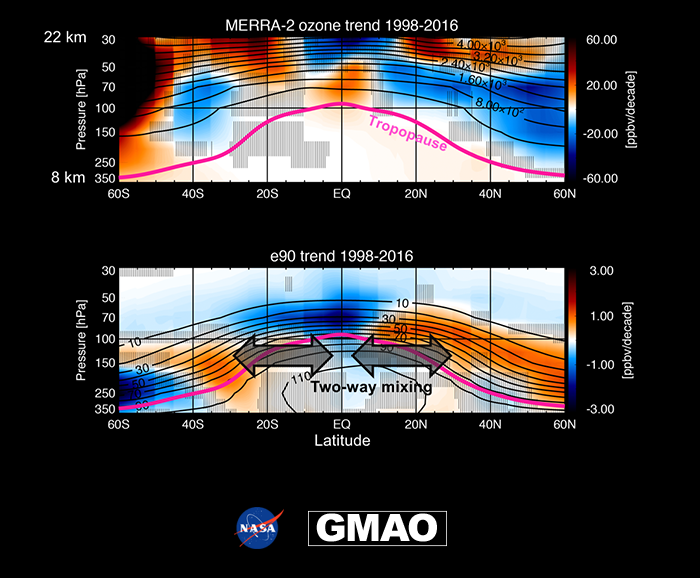Recent decline in lower stratospheric ozone attributed to circulation changes
Stratospheric ozone plays a critical role in the Earth system by shielding the biosphere from harmful ultraviolet radiation and by influencing the planet’s radiative budget. Following a period of decline in the second half of the 20th century, ozone concentrations in the upper stratosphere (above approximately 35 km) have been shown to rise in the past two decades. This is an expected result of the implementation of the Montreal Protocol and its amendments banning emissions of ozone depleting substances into the atmosphere. A clear signal of recovery has recently emerged from satellite observations. The assessment of multidecadal changes in the lower-stratospheric (LS) ozone (12–25 km) is much more difficult owing to large interannual variations and relatively large satellite observation errors in that layer of the atmosphere. However several recent studies hint at the possibility that ozone concentrations in the LS have remained low and perhaps even continue to decline. In particular, a study by Ball et al., 2018 using advanced statistical analysis of several merged satellite data sets found a clear declining trend in the LS.
Atmospheric ozone concentrations are expected to increase after 1998 because of the Montreal Protocol. In MERRA-2, ozone just above the tropopause has continued to decline (blue shading in top panel). An idealized tracer reveals enhanced tropical-extratropical mixing between 1998 and 2016 (bottom panel).
This implies that transport changes between 1998 and 2016 most likely caused ozone in the extratropical lower stratosphere to decline. Either long-term variations or a systematic change in mixing are to blame.

Produced at the GMAO, the Modern-Era Retrospective Analysis for Research and Applications, Version 2 (MERRA-2) is NASA’s reanalysis that combines satellite and conventional observations of atmospheric meteorology and composition with state-of-the-art atmospheric general circulation model simulations to produce a continuous record of the state of the atmosphere as it has evolved since 1980 to present. In particular it represents a sophisticated methodology of merging ozone observations from various satellite instruments at a high spatial and temporal resolution. The top panel shows LS ozone trends derived from MERRA-2 after accounting for inhomogeneities resulting from step changes in the ozone observations between 1998 and 2016. Zonally averaged trends are computed as a function of latitude and pressure using multiple linear regression, which removes the effects of stratospheric aerosols and known quasi-periodic modes of stratospheric ozone variability. Evident is ozone decline of up to 27 parts per billion per decade (2.1% per decade) in an approximately 10-km thick layer above the tropopause outside of the tropics.
In the southern hemisphere that layer is confined to latitudes between 45°S and 30°S and it is much wider in the northern hemisphere (10°N to at least 60°N). It is noted that above approximately 30 km the ozone trends are positive as expected from the decline of ozone depleting substances. In order to understand the origin of these LS ozone trends a behavior of an idealized tracer, 'e90' is analyzed. It is a part of a suite of trace gases from a model simulation conducted with the Global Modeling Initiative (GMI) full chemistry model with dynamics specified from MERRA-2. Termed M2-GMI, this simulation was produced by NASA’s Chemistry and Dynamics Laboratory in collaboration with the GMAO and covers the period 1980 to 2016. The tracer e90 is released in the model uniformly at the Earth’s surface and has a prescribed depletion rate of 90-1 days-1 everywhere in the atmosphere. Unlike ozone, e90 is not subject to complex chemistry and it is, therefore, an excellent indicator of transport patterns. Trends in e90 are shown in the lower panel.
There is a remarkable congruence between the ozone and e90 trends, strongly suggesting a common dynamical, rather than chemical, origin. The sign difference between the two is a consequence of reversed vertical and horizontal gradients in concentrations of e90 and ozone (shown as black contours). The e90 trend pattern is consistent with an intensification of quasi-horizontal two-way mixing bringing e90-rich (ozone-poor) air from the tropics into the high latitudes and vice versa. This vigorous exchange of air masses results from an increase in planetary-scale wave activity in the last two decades, which, as some model simulations suggest, can be a result of increased concentrations of greenhouse gases from fossil fuels. Whether this is the case or the intensification of mixing is an unrelated transient phenomenon will be a subject of further research.
References
Ball, W. T., Alsing, J., Mortlock, D. J., Staehelin, J., Haigh, J. D., Peter, T., Tummon, F., Stübi, R., Stenke, A., Anderson, J., Bourassa, A., Davis, S. M., Degenstein, D., Frith, S., Froidevaux, L., Roth, C., Sofieva, V., Wang, R., Wild, J., Yu, P., Ziemke, J. R., and Rozanov, E. V. 2018, Evidence for a continuous decline in lower stratospheric ozone offsetting ozone layer recovery, Atmos. Chem. Phys., 18, 1379-1394, https://doi.org/10.5194/acp-18-1379-2018
Wargan, K, C. Orbe, S. Pawson, J. R. Ziemke, L. D. Oman, M. A. Olsen, L. Coy, and K. E. Knowland, 2018. Recent decline in extratropical lower stratospheric ozone attributed to circulation changes. Geophys. Res. Lett. https://doi.org/10.1029/2018GL077406

